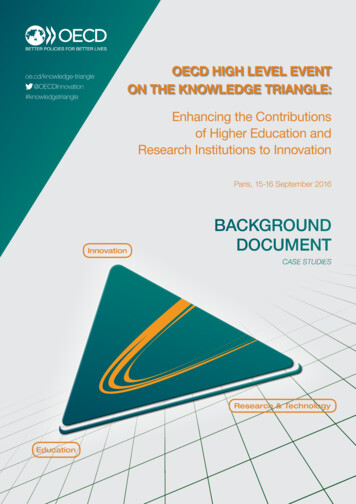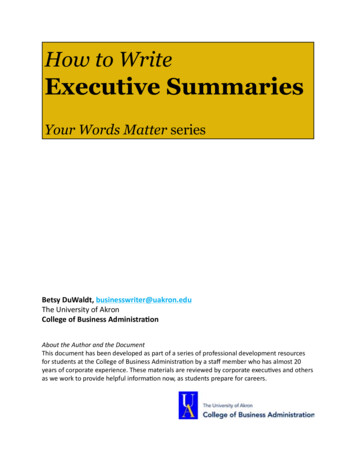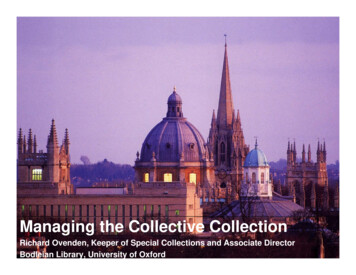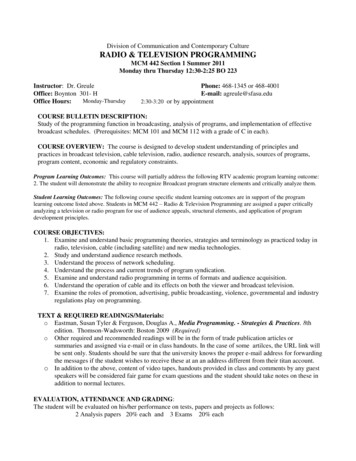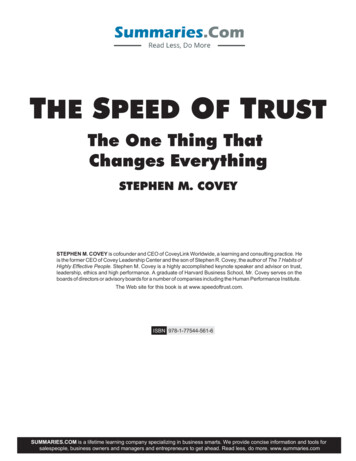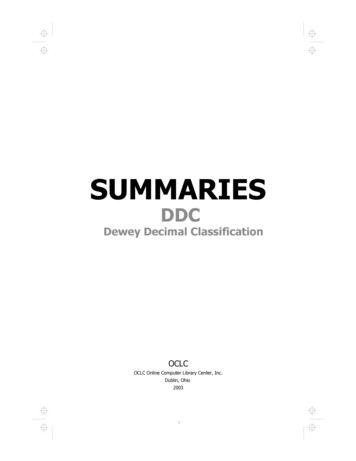
Transcription
SUMMARIESDDCDewey Decimal ClassificationOCLCOCLC Online Computer Library Center, Inc.Dublin, Ohio2003
2003 OCLC Online Computer Library Center, Inc. (“OCLC”)All rights reserved. No part of this publication may be reproduced, stored in a retrieval system, or transmitted,in any form or by any means, electronic, mechanical, photocopying, recording or otherwise, without the priorpermission of OCLC.DDC, Dewey, Dewey Decimal Classification, WebDewey, and WorldCat are registered trademarks and/orservice marks of OCLC. Licensing information regarding the Dewey Decimal Classification system is available atwww.oclc.org/dewey.OCLC Online Computer Library Center, Inc.6565 Frantz RoadDublin, OH 43017-3395 USAwww.oclc.org/deweyISBN 0-910608-71-7The three summaries are reprinted from Dewey Decimal Classification and Relative Index, Edition 22 (DDC 22).
A Brief Introduction to theDewey Decimal ClassificationHistory and Current UseThe Dewey Decimal Classification (DDC) system is a general knowledgeorganization tool that is continuously revised to keep pace with knowledge. Thesystem was conceived by Melvil Dewey in 1873 and first published in 1876. TheDDC is published by OCLC Online Computer Library Center, Inc. OCLC owns allcopyright rights in the Dewey Decimal Classification, and licenses the system for avariety of uses.The DDC is the most widely used classification system in the world. Libraries inmore than 135 countries use the DDC to organize and provide access to theircollections, and DDC numbers are featured in the national bibliographies of morethan 60 countries. Libraries of every type apply Dewey numbers on a daily basisand share these numbers through a variety of means (including WorldCat, theOCLC Online Union Catalog). Dewey is also used for other purposes, e.g., as abrowsing mechanism for resources on the web.The DDC has been translated into over thirty languages. Translations of thelatest full and abridged editions of the DDC are completed, planned, or underway inArabic, Chinese, French, German, Greek, Hebrew, Icelandic, Italian, Korean,Norwegian, Russian, Spanish, and Vietnamese.DevelopmentOne of Dewey’s great strengths is that the system is developed and maintainedin a national bibliographic agency, the Library of Congress. The Dewey editorial officeis located in the Decimal Classification Division of the Library of Congress, whereclassification specialists annually assign over 110,000 DDC numbers to records forworks cataloged by the Library. Having the editorial office within the DecimalClassification Division enables the editors to detect trends in the literature that mustbe incorporated into the Classification. The editors prepare proposed schedulerevisions and expansions, and forward the proposals to the Decimal ClassificationEditorial Policy Committee (EPC) for review and recommended action.EPC is a ten-member international board whose main function is to advise theeditors and OCLC on matters relating to changes, innovations, and the generaldevelopment of the Classification. EPC represents the interests of DDC users; itsmembers come from national, public, special, and academic libraries, and fromlibrary schools.EditionsThe DDC is published in full and abridged editions in print and electronicversions. The abridged edition is a logical truncation of the notational and structuralhierarchy of the corresponding full edition on which it is based, and is intended forgeneral collections of 20,000 titles or less. WebDewey and Abridged WebDewey, theelectronic versions of the full and abridged editions, respectively, are updatedfrequently and contain additional index entries and mapped vocabulary. Theelectronic versions and supplemental web postings are the chief sources of ongoingupdates to the DDC. On the Dewey web site (www.oclc.org/dewey), selected new1
Brief Introduction to the DDCnumbers and changes to the DDC are posted monthly, and mappings betweenselected new Library of Congress Subject Headings (LCSH) and Dewey numbersare posted biweekly.Structure and NotationThe DDC is built on sound principles that make it ideal as a general knowledgeorganization tool: meaningful notation in universally recognized Arabic numerals,well-defined categories, well-developed hierarchies, and a rich network ofrelationships among topics. In the DDC, basic classes are organized by disciplinesor fields of study. At the broadest level, the DDC is divided into ten main classes,which together cover the entire world of knowledge. Each main class is furtherdivided into ten divisions, and each division into ten sections (not all the numbersfor the divisions and sections have been used). The main structure of the DDC ispresented in the DDC Summaries following this introduction. The headingsassociated with the numbers in the summaries have been edited for browsingpurposes, and do not necessarily match the complete headings found in theschedules.The first summary contains the ten main classes. The first digit in eachthree-digit number represents the main class. For example, 600 representstechnology.The second summary contains the hundred divisions. The second digit ineach three-digit number indicates the division. For example, 600 is used forgeneral works on technology, 610 for medicine and health, 620 for engineering,630 for agriculture.The third summary contains the thousand sections. The third digit in eachthree-digit number indicates the section. Thus, 610 is used for general works onmedicine and health, 611 for human anatomy, 612 for human physiology, 613 forpersonal health and safety.Arabic numerals are used to represent each class in the DDC. A decimal pointfollows the third digit in a class number, after which division by ten continues to thespecific degree of classification needed.A subject may appear in more than one discipline. For example, “clothing” hasaspects that fall under several disciplines. The psychological influence of clothingbelongs in 155.95 as part of the discipline of psychology; customs associated withclothing belong in 391 as part of the discipline of customs; and clothing in the senseof fashion design belongs in 746.92 as part of the discipline of the arts.HierarchyHierarchy in the DDC is expressed through structure and notation. Structuralhierarchy means that all topics (aside from the ten main classes) are part of all thebroader topics above them. Any note regarding the nature of a class holds true forall the subordinate classes, including logically subordinate topics classed atcoordinate numbers.Notational hierarchy is expressed by length of notation. Numbers at any givenlevel are usually subordinate to a class whose notation is one digit shorter;coordinate with a class whose notation has the same number of significant digits;2
Brief Introduction to the DDCand superordinate to a class with numbers one or more digits longer. Theunderlined digits in the following example demonstrate this notational hierarchy:600630636636.7636.8TechnologyAgriculture and related technologiesAnimal husbandryDogsCats“Dogs” and “Cats” are more specific than (i.e., are subordinate to) “Animalhusbandry”; they are equally specific as (i.e., are coordinate with) each other; and“Animal husbandry” is less specific than (i.e., is superordinate to) “Dogs” and “Cats.”Sometimes, other devices must be used to express the hierarchy when it is notpossible or desirable to do so through the notation. Special headings, notes, andentries indicate relationships among topics that violate notational hierarchy.Arrangement of the DDCThe print version of the latest full edition of the DDC, Edition 22, is composed ofthe following major parts in four volumes:Volume 1(A) New Features in Edition 22: A brief explanation of the special features andchanges in DDC 22(B) Introduction: A description of the DDC and how to use it(C) Glossary: Short definitions of terms used in the DDC(D) Index to the Introduction and Glossary(E) Manual: A guide to the use of the DDC that is made up primarily of extendeddiscussions of problem areas in the application of the DDC. Information in theManual is arranged by the numbers in the tables and schedules(F) Tables: Six numbered tables of notation that can be added to class numbers toprovide greater specificity(G) Lists that compare Editions 21 and 22: Relocations and Discontinuations;Reused NumbersVolume 2(H) DDC Summaries: The top three levels of the DDC( I) Schedules: The organization of knowledge from 000–5993
Brief Introduction to the DDCVolume 3(J) Schedules: The organization of knowledge from 600–999Volume 4(K) Relative Index: An alphabetical list of subjects with the disciplines in which theyare treated subarranged alphabetically under each entryEntriesEntries in the schedules and tables are composed of a DDC number in thenumber column (the column at the left margin), a heading describing the class thatthe number represents, and often one or more notes. All entries (numbers,headings, and notes) should be read in the context of the hierarchy.In the print version of the DDC, the first three digits of schedule numbers (mainclasses, divisions, sections) appear only once in the number column, when firstused. They are repeated at the top of each page where their subdivisions continue.Subordinate numbers appear in the number column, beginning with a decimalpoint, with the initial three digits understood.Some numbers in the schedules and tables are enclosed in parentheses orsquare brackets. Numbers and notes in parentheses provide options to standardpractice. Numbers in square brackets represent topics that have been relocated ordiscontinued, or are unassigned. Square brackets are also used for standardsubdivision concepts that are represented in another location. Numbers in squarebrackets are never used.Number BuildingOnly a fraction of potential DDC numbers are included in the schedules. It isoften necessary to build or synthesize a number that is not specifically listed in theschedules. Such built numbers allow for greater depth of content analysis. Thereare four sources of notation for building numbers: (A) Table 1 StandardSubdivisions; (B) Tables 2–6; (C) other parts of the schedules; and (D) add tablesin the schedules.Number building is initiated only upon instructions in the schedules (exceptfor the addition of standard subdivisions, which may take place anywhere unlessthere is an instruction to the contrary). Number building begins with a basenumber (always stated in the instruction note) to which another number is added.More InformationThe Dewey web site (www.oclc.org/dewey) contains up-to-date informationabout the DDC, DDC products and services, and DDC licensing. For moreinformation about the structure and application of the Dewey DecimalClassification, consult the introduction in volume 1 of DDC 22 (also available onlinein WebDewey and on the Dewey web site). A more in-depth introduction to theDewey Decimal Classification may be found in Dewey Decimal Classification:Principles and Application, 3d ed., by Lois Mai Chan and Joan S. Mitchell (Dublin,Ohio: OCLC, 2003).4
Summaries
SummariesFirst SummaryThe Ten Main Classes000 Computer science, information & general works100 Philosophy & psychology200 Religion300 Social sciences400 Language500 Science600 Technology700 Arts & recreation800 Literature900 History & geographyConsult schedules for complete and exact headings7
Second SummaryThe Hundred Divisions000010020030040050060070080090Computer science, knowledge & systemsBibliographiesLibrary & information sciencesEncyclopedias & books of facts[Unassigned]Magazines, journals & serialsAssociations, organizations & museumsNews media, journalism & publishingQuotationsManuscripts & rare icsAstronomyPhysicsChemistryEarth sciences & geologyFossils & prehistoric lifeLife sciences; biologyPlants (Botany)Animals etaphysicsEpistemologyParapsychology & occultismPhilosophical schools of thoughtPsychologyLogicEthicsAncient, medieval & eastern philosophyModern western Medicine & healthEngineeringAgricultureHome & family managementManagement & public relationsChemical engineeringManufacturingManufacture for specific usesBuilding & Philosophy & theory of religionThe BibleChristianity & Christian theologyChristian practice & observanceChristian pastoral practice & religious ordersChristian organization, social work & worshipHistory of ChristianityChristian denominationsOther ping & area planningArchitectureSculpture, ceramics & metalworkDrawing & decorative artsPaintingGraphic artsPhotography & computer artMusicSports, games & entertainment300310320330340350360370380390Social sciences, sociology & anthropologyStatisticsPolitical scienceEconomicsLawPublic administration & military scienceSocial problems & social servicesEducationCommerce, communications & transportationCustoms, etiquette & folklore800810820830840850860870880890Literature, rhetoric & criticismAmerican literature in EnglishEnglish & Old English literaturesGerman & related literaturesFrench & related literaturesItalian, Romanian & related literaturesSpanish & Portuguese literaturesLatin & Italic literaturesClassical & modern Greek literaturesOther inguisticsEnglish & Old English languagesGerman & related languagesFrench & related languagesItalian, Romanian & related languagesSpanish & Portuguese languagesLatin & Italic languagesClassical & modern Greek languagesOther raphy & travelBiography & genealogyHistory of ancient world (to ca. 499)History of EuropeHistory of AsiaHistory of AfricaHistory of North AmericaHistory of South AmericaHistory of other areasConsult schedules for complete and exact headings8
Third SummaryThe Thousand Sections000001002003004005006007008009Computer science, information & general worksKnowledgeThe bookSystemsData processing & computer scienceComputer programming, programs & dataSpecial computer 52053054055056057058059General serial publicationsSerials in American EnglishSerials in EnglishSerials in other Germanic languagesSerials in French, Occitan & CatalanIn Italian, Romanian & related languagesSerials in Spanish & PortugueseSerials in Slavic languagesSerials in Scandinavian languagesSerials in other yBibliographiesBibliographies of individuals[Unassigned]Of anonymous & pseudonymous worksBibliographies of works from specific placesBibliographies of works on specific subjectsGeneral subject catalogsCatalogs arranged by author, date, etc.Dictionary catalogs060061062063064065066067068069General organizations & museum scienceOrganizations in North AmericaOrganizations in British Isles; in EnglandOrganizations in central Europe; in GermanyOrganizations in France & MonacoOrganizations in Italy & adjacent islandsIn Iberian Peninsula & adjacent islandsOrganizations in eastern Europe; in RussiaOrganizations in other geographic areasMuseum science020021022023024025026027028029Library & information sciencesLibrary relationshipsAdministration of physical plantPersonnel management[Unassigned]Library operationsLibraries for specific subjectsGeneral librariesReading & use of other information s media, journalism & publishingNewspapers in North AmericaNewspapers in British Isles; in EnglandNewspapers in central Europe; in GermanyNewspapers in France & MonacoNewspapers in Italy & adjacent islandsIn Iberian Peninsula & adjacent islandsNewspapers in eastern Europe; in RussiaNewspapers in ScandinaviaNewspapers in other geographic areas030031032033034035036037038039General encyclopedic worksEncyclopedias in American EnglishEncyclopedias in EnglishIn other Germanic languagesEncyclopedias in French, Occitan & CatalanIn Italian, Romanian & related languagesEncyclopedias in Spanish & PortugueseEncyclopedias in Slavic languagesEncyclopedias in Scandinavian languagesEncyclopedias in other languages080081082083084085086087088089General collectionsCollections in American EnglishCollections in EnglishCollections in other Germanic languagesCollections in French, Occitan & CatalanIn Italian, Romanian & related languagesCollections in Spanish & PortugueseCollections in Slavic languagesCollections in Scandinavian languagesCollections in other assigned]090091092093094095096097098099Manuscripts & rare booksManuscriptsBlock booksIncunabulaPrinted booksBooks notable for bindingsBooks notable for illustrationsBooks notable for ownership or originProhibited works, forgeries & hoaxesBooks notable for formatConsult schedules for complete and exact headings9
Dewey Decimal losophy & psychologyTheory of philosophyMiscellanyDictionaries & encyclopedias[Unassigned]Serial publicationsOrganizations & managementEducation, research & related topicsKinds of persons treatmentHistorical & collected persons Unassigned]Perception, movement, emotions & drivesMental processes & intelligenceSubconscious & altered statesDifferential & developmental psychologyComparative psychology[Unassigned]Applied eChangeStructureForce & energyNumber & onDeduction[Unassigned][Unassigned]Fallacies & sources of errorSyllogismsHypothesesArgument & stemology, causation & humankindEpistemologyCausationDeterminism & indeterminismTeleology[Unassigned]The selfThe unconscious & the subconsciousHumankindOrigin & destiny of individual souls170171172173174175176177178179EthicsEthical systemsPolitical ethicsEthics of family relationshipsOccupational ethicsEthics of recreation & leisureEthics of sex & reproductionEthics of social relationsEthics of consumptionOther ethical norms130131132133134135136137138139Parapsychology & occultismParapsychological & occult methods[Unassigned]Specific topics in parapsychology & occultism[Unassigned]Dreams & mysteries[Unassigned]Divinatory 86187188189Ancient, medieval & eastern philosophyEastern philosophyPre-Socratic Greek philosophiesSocratic & related philosophiesPlatonic philosophyAristotelian philosophySkeptic & Neoplatonic philosophiesEpicurean philosophyStoic philosophyMedieval western philosophy140141142143144145146147148149Specific philosophical schoolsIdealism & related systemsCritical philosophyBergsonism & intuitionismHumanism & related systemsSensationalismNaturalism & related systemsPantheism & related systemsEclecticism, liberalism & traditionalismOther philosophical systems190191192193194195196197198199Modern western philosophyPhilosophy of United States & CanadaPhilosophy of British IslesPhilosophy of Germany & AustriaPhilosophy of FrancePhilosophy of ItalyPhilosophy of Spain & PortugalPhilosophy of former Soviet UnionPhilosophy of ScandinaviaPhilosophy in other geographic areasConsult schedules for complete and exact headings10
Religious mythology & social theologyDoctrinesPublic worship & other practicesReligious experience, life & practiceReligious ethicsLeaders & organizationMissions & religious educationSourcesSects & reform movements250251252253254255256257258259Christian orders & local churchPreachingTexts of sermonsPastoral office & workParish administrationReligious congregations & orders[Unassigned][Unassigned][Unassigned]Pastoral care of families & kinds of persons210211212213214215216217218219Philosophy & theory of religionConcepts of GodExistence, knowability & attributes of GodCreationTheodicyScience & ed]260261262263264265266267268269Social & ecclesiastical theologySocial theologyEcclesiologyDays, times & places of observancePublic worshipSacraments, other rites & actsMissionsAssociations for religious workReligious educationSpiritual renewal220221222223224225226227228229BibleOld Testament (Tanakh)Historical books of Old TestamentPoetic books of Old TestamentProphetic books of Old TestamentNew TestamentGospels & ActsEpistlesRevelation (Apocalypse)Apocrypha & y of Christianity & Christian churchReligious orders in church historyPersecutions in church historyDoctrinal controversies & heresiesHistory of Christianity in EuropeHistory of Christianity in AsiaHistory of Christianity in AfricaHistory of Christianity in North AmericaHistory of Christianity in South AmericaHistory of Christianity in other areas230231232233234235236237238239Christianity & Christian theologyGodJesus Christ & his familyHumankindSalvation & graceSpiritual beingsEschatology[Unassigned]Creeds & catechismsApologetics & polemics280281282283284285286287288289Christian denominations & sectsEarly church & Eastern churchesRoman Catholic ChurchAnglican churchesProtestants of Continental originPresbyterian, Reformed & CongregationalBaptist, Disciples of Christ & AdventistMethodist & related churches[Unassigned]Other denominations & sects240241242243244245246247248249Christian moral & devotional theologyChristian ethicsDevotional literatureEvangelistic writings for individuals[Unassigned][Unassigned]Use of art in ChristianityChurch furnishings & articlesChristian experience, practice & lifeChristian observances in family life290291292293294295296297298299Other religions[Unassigned]Greek & Roman religionGermanic religionReligions of Indic originZoroastrianismJudaismIslam, Babism & Bahai Faith(Optional number)Religions not provided for elsewhereConsult schedules for complete and exact headings11
Dewey Decimal ial sciencesSociology & anthropologySocial interactionSocial processesFactors affecting social behaviorSocial groupsCulture & 351352353354355356357358359Public administration & military sciencePublic administrationGeneral considerations of public administrationSpecific fields of public administrationAdministration of economy & environmentMilitary scienceInfantry forces & warfareMounted forces & warfareAir & other specialized forcesSea forces & warfare310311312313314315316317318319Collections of general ral statistics of EuropeGeneral statistics of AsiaGeneral statistics of AfricaGeneral statistics of North AmericaGeneral statistics of South AmericaGeneral statistics of other areas360361362363364365366367368369Social problems & services; associationsSocial problems & social welfare in generalSocial welfare problems & servicesOther social problems & servicesCriminologyPenal & related institutionsAssociationsGeneral clubsInsuranceMiscellaneous kinds of l scienceSystems of governments & statesRelation of state to organized groupsCivil & political rightsThe political processInternational migration & colonizationSlavery & emancipationInternational relationsThe legislative ducationSchools & their activities; special educationElementary educationSecondary educationAdult educationCurricula[Unassigned][Unassigned]Higher educationPublic policy issues in bor economicsFinancial economicsEconomics of land & energyCooperativesSocialism & related systemsPublic financeInternational economicsProductionMacroeconomics & related topics380381382383384385386387388389Commerce, communications & transportationCommerceInternational commercePostal communicationCommunications; telecommunicationRailroad transportationInland waterway & ferry transportationWater, air & space transportationTransportation; ground transportationMetrology & w of nationsConstitutional & administrative lawMilitary, tax, trade & industrial lawLabor, social, education & cultural lawCriminal lawPrivate lawCivil procedure & courtsLaws, regulations & casesLaw of specific jurisdictions & areas390391392393394395396397398399Customs, etiquette & folkloreCostume & personal appearanceCustoms of life cycle & domestic lifeDeath customsGeneral customsEtiquette (Manners)[Unassigned][Unassigned]FolkloreCustoms of war & diplomacyConsult schedules for complete and exact headings12
Philosophy & theoryMiscellanyDictionaries & encyclopediasSpecial topicsSerial publicationsOrganizations & managementEducation, research & related topicsKinds of persons treatmentGeographic & persons treatment450451452453454455456457458459Italian, Romanian & related languagesItalian writing systems & phonologyItalian etymologyItalian dictionaries[Unassigned]Italian grammar[Unassigned]Italian language variationsStandard Italian usageRomanian & related Writing systemsEtymologyDictionariesPhonology & phoneticsGrammar[Unassigned]Dialectology & historical linguisticsStandard usage & applied linguisticsSign languages460461462463464465466467468469Spanish & Portuguese languagesSpanish writing systems & phonologySpanish etymologySpanish dictionaries[Unassigned]Spanish grammar[Unassigned]Spanish language variationsStandard Spanish sh & Old EnglishEnglish writing system & phonologyEnglish etymologyEnglish dictionaries[Unassigned]English grammar[Unassigned]English language variationsStandard English usageOld English (Anglo-Saxon)470471472473474475476477478479Italic languages; LatinClassical Latin writing & phonologyClassical Latin etymologyClassical Latin dictionaries[Unassigned]Classical Latin grammar[Unassigned]Old, postclassical & Vulgar LatinClassical Latin usageOther Italic languages430431432433434435436437438439Germanic languages; GermanGerman writing systems & phonologyGerman etymologyGerman dictionaries[Unassigned]German grammar[Unassigned]German language variationsStandard German usageOther Germanic languages480481482483484485486487488489Hellenic languages; classical GreekClassical Greek writing & phonologyClassical Greek etymologyClassical Greek dictionaries[Unassigned]Classical Greek grammar[Unassigned]Preclassical & postclassical GreekClassical Greek usageOther Hellenic languages440441442443444445446447448449Romance languages; FrenchFrench writing systems & phonologyFrench etymologyFrench dictionaries[Unassigned]French grammar[Unassigned]French language variationsStandard French usageOccitan & Catalan490491492493494495496497498499Other languagesEast Indo-European & Celtic languagesAfro-Asiatic languages; Semitic languagesNon-Semitic Afro-Asiatic languagesAltaic, Uralic, Hyperborean & DravidianLanguages of East & Southeast AsiaAfrican languagesNorth American native languagesSouth American native languagesAustronesian & other languagesConsult schedules for complete and exact headings13
Dewey Decimal ural sciences & mathematicsPhilosophy & theoryMiscellanyDictionaries & encyclopedias[Unassigned]Serial publicationsOrganizations & managementEducation, research & related topicsNatural historyHistorical, geographic & persons treatment550551552553554555556557558559Earth sciencesGeology, hydrology & meteorologyPetrologyEconomic geologyEarth sciences of EuropeEarth sciences of AsiaEarth sciences of AfricaEarth sciences of North AmericaEarth sciences of South AmericaEarth sciences of other ral principles of ry[Unassigned]Numerical analysisProbabilities & applied ogy; paleozoologyPaleobotany; fossil microorganismsFossil invertebratesFossil marine & seashore invertebratesFossil mollusks & molluscoidsFossil arthropodsFossil chordatesFossil cold-blooded vertebrates; fossil fishesFossil birdsFossil mammals520521522523524525526527528529Astronomy & allied sciencesCelestial mechanicsTechniques, equipment & materialsSpecific celestial bodies & phenomena[Unassigned]Earth (Astronomical geography)Mathematical geographyCelestial 76577578579Life sciences; biologyPhysiology & related subjectsBiochemistrySpecific physiological systems in animals[Unassigned]Specific parts of & systems in plantsGenetics & evolutionEcologyNatural history of organismsMicroorganisms, fungi & l mechanics; solid mechanicsFluid mechanics; liquid mechanicsGas mechanicsSound & related vibrationsLight & infrared & ultraviolet phenomenaHeatElectricity & electronicsMagnetismModern physics580581582583584585586587588589Plants (Botany)Specific topics in natural historyPlants noted for characteristics & flowersDicotyledonsMonocotyledonsGymnosperms; conifersSeedless plantsVascular seedless 47548549Chemistry & allied sciencesPhysical chemistryTechniques, equipment & materialsAnalytical chemistry[Unassigned][Unassigned]Inorganic chemistryOrganic 95596597598599Animals (Zoology)Specific topics in natural historyInvertebratesMarine & seashore invertebratesMollusks & molluscoidsArthropodsChordatesCold-blooded vertebrates; fishesBirdsMammalsConsult schedules for complete and exact headings14
Summa
(D) Index to the Introduction and Glossary (E) Manual: A guide to the use of the DDC that is made up primarily of extended discussions of problem areas in the application of the DDC. Information in the Manual is arranged by the numbers in the tables and schedules (F) Tables: Six numbered

